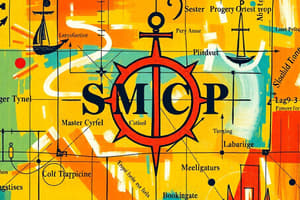Podcast
Questions and Answers
A vessel is approaching a narrow channel with limited visibility due to fog. Which SMCP phrase would be MOST appropriate to signal their intentions to other nearby vessels?
A vessel is approaching a narrow channel with limited visibility due to fog. Which SMCP phrase would be MOST appropriate to signal their intentions to other nearby vessels?
- "I am passing buoy number one to port."
- "I am entering \[channel name], proceeding with caution." (correct)
- "Advise you alter course to starboard."
- "What is your intention?"
During heavy weather, a crew member reports to the bridge that they observed significant structural stress on the hull plating near the starboard quarter. What specific nautical term would the officer on watch MOST likely use to accurately log this information in the ship's logbook?
During heavy weather, a crew member reports to the bridge that they observed significant structural stress on the hull plating near the starboard quarter. What specific nautical term would the officer on watch MOST likely use to accurately log this information in the ship's logbook?
- Forward Starboard Side
- Aft Port Side
- Aft Starboard Side (correct)
- Forward Port Side
A vessel's draft is observed to have significantly increased after loading cargo in a freshwater port compared to its draft in saltwater. What is the MOST likely reason for this difference?
A vessel's draft is observed to have significantly increased after loading cargo in a freshwater port compared to its draft in saltwater. What is the MOST likely reason for this difference?
- Freshwater is less dense than saltwater, causing the vessel to sink lower in the water. (correct)
- The vessel's Plimsoll line is incorrectly marked, leading to inaccurate *draft* readings.
- The change in *draft* is due to thermal expansion of the hull in warmer climates.
- The vessel has taken on additional ballast water to compensate for the weight of the cargo.
During a Port State Control inspection, deficiencies are found related to the crew's ability to effectively communicate in accordance with SOLAS Chapter V regulations. What is the MOST probable action the Port State Control officer will take?
During a Port State Control inspection, deficiencies are found related to the crew's ability to effectively communicate in accordance with SOLAS Chapter V regulations. What is the MOST probable action the Port State Control officer will take?
A ship is navigating through a region known for severe tropical cyclones. The latest meteorological report indicates rapidly decreasing barometric pressure. Which action would be MOST appropriate according to best practices?
A ship is navigating through a region known for severe tropical cyclones. The latest meteorological report indicates rapidly decreasing barometric pressure. Which action would be MOST appropriate according to best practices?
During a bunkering operation, a small spill of fuel oil occurs on the deck due to a faulty valve. What immediate actions should the crew take, according to established shipboard routines and procedures, to minimize environmental impact and comply with regulations?
During a bunkering operation, a small spill of fuel oil occurs on the deck due to a faulty valve. What immediate actions should the crew take, according to established shipboard routines and procedures, to minimize environmental impact and comply with regulations?
A vessel is preparing to load a cargo of perishable goods. Which of the following considerations related to cargo handling is MOST crucial to ensure the quality of the cargo upon arrival?
A vessel is preparing to load a cargo of perishable goods. Which of the following considerations related to cargo handling is MOST crucial to ensure the quality of the cargo upon arrival?
While acting as watchkeeping officer, you notice the main engine's exhaust temperature is gradually increasing, despite all other parameters appearing normal. This discrepancy could indicate:
While acting as watchkeeping officer, you notice the main engine's exhaust temperature is gradually increasing, despite all other parameters appearing normal. This discrepancy could indicate:
During pilotage, the pilot requests the heading but receives conflicting information from the helmsman and the gyrocompass repeater. What is the MOST appropriate immediate action?
During pilotage, the pilot requests the heading but receives conflicting information from the helmsman and the gyrocompass repeater. What is the MOST appropriate immediate action?
A newly employed crew member, unfamiliar with maritime English, is assigned to assist in securing cargo on deck. Despite clear instructions, they consistently misunderstand commands, leading to potentially unsafe practices. Which strategy would be MOST effective in addressing this communication barrier and ensuring safety?
A newly employed crew member, unfamiliar with maritime English, is assigned to assist in securing cargo on deck. Despite clear instructions, they consistently misunderstand commands, leading to potentially unsafe practices. Which strategy would be MOST effective in addressing this communication barrier and ensuring safety?
Flashcards
Maritime English
Maritime English
Specialized use of English in the maritime industry for safe and efficient communication.
SMCP
SMCP
A standardized vocabulary and set of phrases developed by the IMO for maritime communication.
Bow
Bow
Front part of a ship.
Stern
Stern
Signup and view all the flashcards
Port
Port
Signup and view all the flashcards
Starboard
Starboard
Signup and view all the flashcards
Loading
Loading
Signup and view all the flashcards
Safety drills
Safety drills
Signup and view all the flashcards
Knot
Knot
Signup and view all the flashcards
Bunkering
Bunkering
Signup and view all the flashcards
Study Notes
- Maritime English refers to the specialized use of the English language in the maritime industry
- It is crucial for safe and efficient communication at sea, in ports, and on ships
Importance of Maritime English
- Ensures clear communication between crew members of different nationalities
- Prevents misunderstandings that could lead to accidents or hazardous situations
- Essential for understanding and following international maritime regulations and procedures
- Facilitates communication with shore-based personnel, such as port authorities and pilots
- Vital for distress and safety communications
Key Areas of Maritime English
- Standard Marine Communication Phrases (SMCP): A standardized vocabulary and set of phrases developed by the International Maritime Organization (IMO)
- Nautical terminology: Specific terms related to ship operations, navigation, and maritime equipment
- Shipboard routines and procedures: Language used in daily tasks, drills, and emergency situations
- Cargo handling: Terms and phrases related to loading, discharging, and securing cargo
- Meteorology: Describing weather conditions and forecasts
- Maritime law and regulations: Understanding and interpreting legal documents and requirements
- Communication with port authorities: Interactions related to berthing, pilotage, and customs
Standard Marine Communication Phrases (SMCP)
- Developed by the IMO to standardize communication and enhance safety at sea
- Consists of a vocabulary of essential words and a collection of set phrases
- Designed to be simple, concise, and easily understood by speakers of different languages
- Covers a wide range of situations, including navigation, maneuvering, safety, and cargo operations
- Regularly updated to reflect changes in maritime technology and regulations
Nautical Terminology
- Bow: The front part of a ship
- Stern: The rear part of a ship
- Port: The left side of a ship when facing forward
- Starboard: The right side of a ship when facing forward
- Deck: A floor or platform on a ship
- Bridge: The control center of a ship, where the captain and officers navigate
- Galley: The kitchen on a ship
- Engine room: The compartment where the ship's engines are located
- Draft: The vertical distance between the waterline and the bottom of the hull
- Freeboard: The distance between the waterline and the main deck
- Knot: A unit of speed equal to one nautical mile per hour
- Bearing: The direction of an object relative to the ship's heading
- Course: The direction in which a ship is steered
- Heading: The direction in which a ship's bow is pointing
Shipboard Routines and Procedures
- Safety drills: Exercises conducted regularly to prepare crew members for emergencies
- Watchkeeping: The practice of assigning crew members to monitor the ship's systems and surroundings
- Maintenance: Regular upkeep of the ship's equipment and machinery
- Reporting: Communicating important information to the captain or other officers
- Bunkering: The process of refueling a ship
Cargo Handling
- Loading: The process of placing cargo onto a ship
- Discharging: The process of removing cargo from a ship
- Securing: The process of fastening cargo to prevent it from shifting during transit
- Stowage: The arrangement of cargo within the ship's holds
- Manifest: A document listing the cargo on board a ship
- Dunnage: Materials used to protect cargo during transit
Meteorology
- Wind speed and direction: Measuring and reporting wind conditions
- Visibility: The distance at which objects can be clearly seen
- Sea state: The condition of the sea surface, including wave height and frequency
- Precipitation: Rainfall, snow, or other forms of moisture
- Temperature: Air and sea temperature readings
- Barometric pressure: Atmospheric pressure readings, used to forecast weather changes
Maritime Law and Regulations
- International Maritime Organization (IMO): A United Nations agency responsible for maritime safety and security
- Safety of Life at Sea (SOLAS) Convention: An international treaty addressing maritime safety standards
- International Regulations for Preventing Collisions at Sea (COLREGS): Rules for avoiding collisions between ships
- Maritime Labour Convention (MLC): An international treaty protecting the rights of seafarers
- Port State Control (PSC): Inspections of foreign ships to ensure compliance with international regulations
Communication with Port Authorities
- Pilotage: The use of a local expert to guide a ship into or out of a port
- Berthing: The process of bringing a ship alongside a pier or dock
- Customs clearance: Procedures for clearing cargo and crew through customs
- Immigration: Procedures for entering or leaving a country
- Port security: Measures taken to protect ports from terrorism and other threats
Challenges in Maritime Communication
- Language barriers: Crew members from different countries may have difficulty understanding each other
- Background noise: Engine noise, wind, and other environmental factors can interfere with communication
- Technical issues: Malfunctions in communication equipment can disrupt communication
- Stress and fatigue: Crew members may be tired or stressed, which can impair their ability to communicate effectively
- Cultural differences: Different cultures may have different communication styles, which can lead to misunderstandings
Strategies for Effective Maritime Communication
- Use Standard Marine Communication Phrases (SMCP)
- Speak clearly and slowly
- Use simple language
- Confirm understanding
- Be aware of cultural differences
- Use visual aids when possible
- Maintain communication equipment
- Promote a culture of open communication
Training and Assessment in Maritime English
- Specific courses are designed to improve maritime English skills
- Assessment methods include written tests, oral exams, and practical exercises
- Simulators are utilized to replicate real-world communication scenarios
- Certification is available to demonstrate proficiency in maritime English
Studying That Suits You
Use AI to generate personalized quizzes and flashcards to suit your learning preferences.



